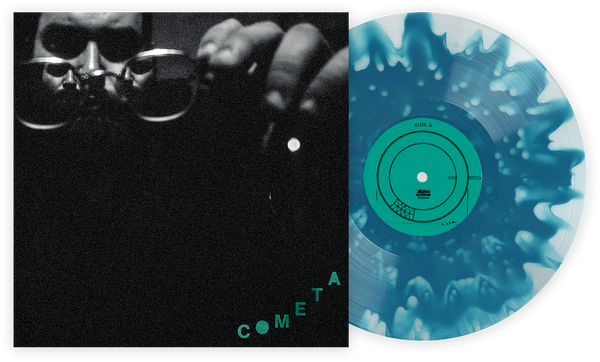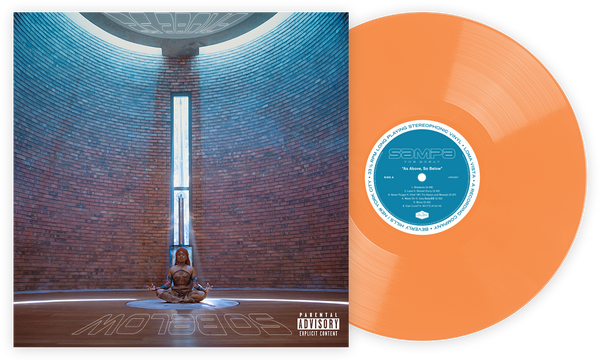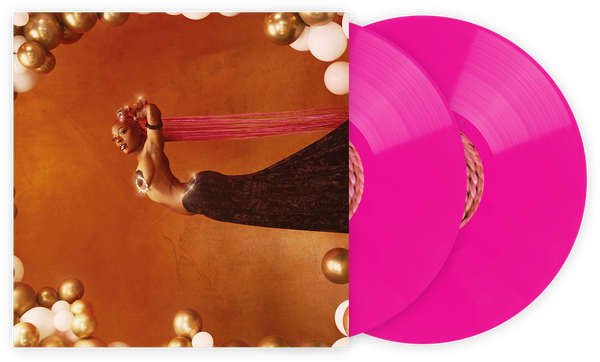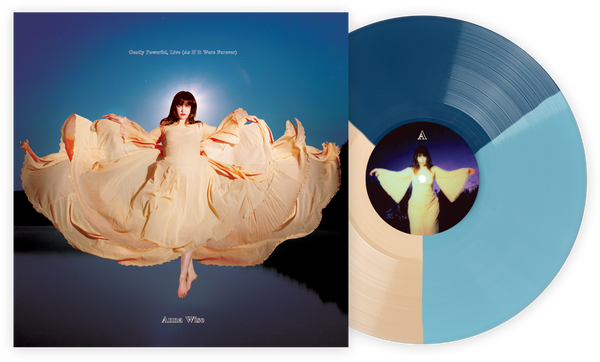The Music and Mystique of Betty Davis
Read The Liner Notes To The Funk Singer's Debut LP
These excerpted Liner Notes appeared for the first time on Light in the Attic’s reissue of Betty Davis in 2007.
For the last 30 years or so, the way most people discovered anything about Betty Davis was the same as I did: by flipping through LP bins in a record store. Her album covers leapt out at you - a young, beautiful Black woman with a massive Afro, sporting either a space-age go-go outfit or a bizarre, pseudo-Egyptian get-up accessorized by three silver javelins. As the title of her second album declared, They Say I'm Different. Yeah, no kidding.
For a very long time, it was very hard to learn anything about the woman behind the cover. It's widely known she was once married to Miles Davis (hence her surname) but that's hardly enough to explain how a former First Lady of Jazz became the leading Femme Fatale of Funk. Moreover, if you scanned the credits on her albums, you realized that Betty wasn't merely a mouthpiece for a male producer or songwriter but an artist in her own right, an independent visionary in an era where Black female solo artists were a rarity. In a show of independence that has few comparisons, then or now, Betty wrote every song she ever recorded and produced every album after her first. That puts her in rarefied company among all musical artists, male or female. Yet, despite an earned reputation as being ahead of her time, it seems that time never caught up to her.
Decades later and Betty Davis is still as enigmatic and enthralling as she ever has been. Her songs regularly appear on funk anthologies. Rappers from Ice Cube to Talib Kweil to Ludacris have rhymed over her tracks. Yet, despite the intense interest around her, surprisingly few details have filled in the blanks in her life and career.
True, we were able to talk to Betty at length - one of only a handful of interviews she's consented to over the last 30 years. We tracked down and spoke to old acquaintances like producer Greg Errico, musical director Fred Mills and percussionist (plus ex-flame) Michael Carabello. We had access to exclusive transcripts and testimonials, blew the dust off old reviews and interviews. All of this information helps broaden and deepen our knowledge of Betty but even then, it's not always easy to separate fact and fiction. When it comes to Ms. Betty Mabry/Davis, the myths are sometimes the closest we can come to the truth.
Get Ready for Betty
Here's what (we think) we know: Betty Mabry was born on July 26, 1945 - a Leo appropriately enough. At the time, her family lived in Durham, North Carolina but she also spent time at her grandmother's farm in Reidsville, 60 miles northwest.
Betty credits both her mother and grandmother for introducing her to music through the many blues albums they would play in their home. In her official bio from 1974, she noted, "my whole family is musical. My grandmother's got a valuable record collection - B.B. King, Jimmy Reed, Elmore James and all those people. I know some English guitarist who would love to get their hands on it."
What attracted her to the blues was, in her words, "the pureness" - the frank honesty of its stories, the rawness of the music. Inspired by these examples, Betty began writing songs at an early age: "I always wrote music. I've been writing music since I was 12," including one childhood ditty entitled, "I'm Going to Bake That Cake of Love."
Sometime in the mid-to-late 1950s - she says when she was nine but other interviews indicate she was closer to 12 - Betty's father found work as a steelworker and the family moved up to Homestead, a modest borough right at the edge of Pittsburgh, home to one of the biggest steel factories in the country at the time. She grew up there until age 16, when Betty left Homestead and joined her aunt out in New York City, enrolling at the Fashion Institute of Technology where she studied apparel design.

Couture wasn't her only interest though, and she would visit clubs like The Bitter Inn and Café Go-Go and listen to folk - still a major genre at that point in the early '60s. While it's hard to imagine a future funk screamer like Betty being a folkie too, she explains, "there was a certain purity in folk music, just like in the blues." She spent so much time around folk groups that one even tried to sign her after she attended an open audition. She declined.
If there is one thing about Betty's musical career that people agree upon it's that she had a laser focus in knowing what she wanted to accomplish and wasn't shy about creating opportunities for herself. With Courtney, she approached him about producing a song for her and through that, Betty Mabry had her first single: "The Cellar." Betty couldn't recall what exact year it came out or what label it appeared on yet she did remember some of the lyrics that went with this uptempo soul cooker: "Where you going fellas, so fly? / I'm going to the Cellar, my oh my. / What you going to do there? / We're going to boogaloo there."
It was around this time that Betty was hanging out at the Electric Circus and the resident heroes there were the Chambers Brothers. As with Courtney and Costa, Betty seized whatever opportunities she could help create: "I was introduced to (the Chambers Brothers) and I told them that I had a song that I thought they would like, that would be good for them." She was able to convince their producer that her songwriting skills had merit and the Brothers ended up recording her song, "Uptown (to Harlem)" on 1967's The Time Has Come. The album was a major success for the Brothers but Betty was already moving onto other things, namely a career as a fashion model.
Betty picked an opportune time to enter the modeling world in the late 1960s - doors that might have been closed before to a Black woman - even one as striking as Betty - had been opened and Betty soon found consistent work through the highly regarded Wilhemina agency. However, though the money was good, Betty never felt very inspired by the work. As she put it in her bio, "I didn't like modeling because you didn't need brains to do it. It's only going to last as long as you look good."
As it turned out, her modeling career would be short-lived but not for lack of looks. Betty met a man at a jazz club. He was older, almost 20 years her senior, but like her, he loved music. He was even known to play the trumpet now and then. His name was Miles Davis.
From Miss Mabry to Mrs. Davis
When Miles and Betty met at the Village Gate in 1967, she didn't even know who he was at first. According to a story shared by Denise Oliver-Velez with writer John Balton, "(Betty) had heard some trumpet player on an accidental entry into a jazz club. The trumpet player was wearing (in Betty's words) 'cool grey suede shoes.' The next day she demanded that I find out 'who was the dude with the shoes.'"
After a off-and-on courtship, she and Miles reconnected and he proposed to her. It was not a match made in heaven, though one could say that about most of Miles' marriages. The jazz leader's temper and penchant for abusing women was something he admitted to in his own autobiography and Betty told Mojo’s James Maycock that Miles' violent tendencies were what ultimately ended their year-long marriage.
That said, as two musically minded partners, Miles and Betty both left an immense impact on one another. Despite the drastic shortcomings in their marriage, it's hard to deny that Miles was the ultimate music teacher and Betty has always acknowledged that she learned much from him in that respect.
Miles must have believed in her talent too since he started to produce an album for Betty that was to appear on Columbia and they had gotten as far as recording a few songs including Jack Bruce and Eric Clapton's "The Politician." Betty described the sound of the album as "progressive... it was hard and heavy" and she was getting help from Wayne Shorter with her charts, plus had players like drummer Tony Williams and bassist Billy Cox.
The album was ultimately shelved and it's not clear if Columbia decided to pass on it or if Miles deliberately canned it (it came out in 2016). What Betty says is that, "He was really scared to release (the album) he told me because he thought I would leave him." Yet, despite this belief, Betty was not bitter about the failed opportunity - she told me, "it wasn't meant to be," and as it was, her comments in her 1974 bio suggest that she preferred not having Miles be the force behind her music: "I believe in being taken seriously, not coasting on my husband's name. I could always have recorded with (Arista Record's) Clive (Davis) or (Atlantic Record's) Ahmet (Ertegun) but I would never truly know if I were being humored because I was Miles' wife."

Ironically, if Betty's burgeoning talent and independent spirit was threatening to Miles, he certainly played a role in helping nurture it. Betty recalls that after she got married, she stopped writing songs and was "really scared because I wasn't anything and I didn't know what happened." However, Miles reassured her: "he told me not to be afraid - I was just developing something else. Maybe he planted that seed in my head. Maybe I wasn't developing anything else until he said it. What I started doing was arranging. I would take songs I had written and I would arrange the music behind them."
What is strange is that Betty barely appears in Miles autobiography except for a few short comments, none of which were particularly flattering, including calling her a "super groupie." However, as indicated with Miles' reluctance to help Betty put her album out, it seems likely that his wife's talents threatened his own sense of security. Miles may have been a living legend but with Betty, he didn't find some starstruck, naive girl waiting to be swept off her feet. Instead, he found a vivacious, spirited, independently-minded woman whose own musical knowledge and social networks would help take the staid king of the uptown jazz scene into a downtown world of artists, rockers and other bohos.
In some circles, Betty and her friends - which included Jimi Hendrix's on-again, off-again girlfriend Devon Wilson - were known as "the cosmic ladies" and no less than Carlos Santana felt that these women, lead by Betty, had a profound effect on Miles' artistic evolution.
In his essay, "Remembering Miles," Santana noted, "you could see how these ladies were affecting Miles. They changed the way he dressed, the places he went, and the music he listened to. Largely because of their influence, Miles really began to check out James Brown and Sly Stone, and he started hanging out with Jimi... I have always thought that Bitches Brew was, in its own way, a tribute in Miles' language to those women who opened his eyes to a whole new world and who encouraged and prodded him to take that next big step."

The Making of Betty Davis
When Betty came out to the Bay Area around 1972, her timing couldn't have been better. Greg Errico, former drummer of Sly and the Family Stone recalls, "We were working on a record and [she came] by the studio one day, because I guess she wanted to meet me. She (told) me that day that she was going to do a record and wanted me to produce it." This despite the fact that Betty couldn't have known much about Errico's experience as a producer - he barely had any at the time - and likewise, Errico knew very little about Betty's musical history outside of her marriage to Miles. However, as Errico remembers it, "she was pretty aggressive, so we got into (the album) pretty quick and at the time, Jesus, I mean the musicians that were assembled were the who's who of the Bay Area at the time."
Errico wasn't exaggerating. He managed to bring together one of the most impressive studio bands you could have wished for in the Bay Area at that time, especially for a project that was destined to be funky, funky, funky. Errico had already been making plans to record with former bandmate and bassist Larry Graham - arguably the greatest funk bassist in that era - as well as former Santana guitarist Neal Schon. They were the anchor of the rhythm section but the talent didn't stop there.
Sharing guitar duties with Schon was Doug Rodrigues who played for the Voices of East Harlem, Buzzy Linhart's band and later, Mandrill. Hershall Kennedy was the organist and would soon become part of Graham Central Station along with Larry. Merl Saunders, a frequent collaborator with Jerry Garcia and the Grateful Dead added his clavinet to a few songs. Amongst the back-up vocalists included Kathi McDonald (Insane Asylum), Patrice Banks (Graham Central Station), future disco king Sylvester, and a local Bay Area trio just on the verge of hitting it big time: The Pointer Sisters. All in all, it was an all-star ensemble yet for an artist who was essentially unproven.
Of the eight songs that appeared on the album, at least two were older songs that she had originally written for the Commodores (who Betty wrote for when they first got signed to Motown): "Welkin Up the Road" and "Game Is My Middle Name." The rest were all new songs and apart from the songwriting, Betty was also brainstorming potential arrangements. Errico recalled going to a North Beach club called Andre for jam sessions where the songs would take shape. Betty would bring her tape recorder and then, according to Errico, Betty would start singing, "ok, here it is - "doo-doo-doo-do-doo.' She would just hum a line and we would play and start jamming a bit. They all started from simple little lines, she would just hum it and then we could create the rhythm, the chord changes to go with it or a bridge and that's it, you know - just that raw funk."

Then there was the question of Betty's singing. Patrice Banks, who sang back-up for Betty's album before Graham Central Station put it bluntly when John Ballon interviewed her: "I never did really understand (her voice). She couldn't sing. I respected her song writing. I liked her songs. I loved the tracks, and with Larry and Greg and all of them playing on it, they were all as funky as they could possibly get. And I had to respect the fact that she knew where to go to get her music done the correct way, but her voice - I never did really understand." Of course, Betty never thought of herself as a finesse singer either and her singing heroes - bluesmen like Muddy Waters and John Lee Hooker - reflect that. Yet, because the tracks were so funky and gritty, the rough, jagged edge of Betty's voice actually enhanced that aesthetic in ways that someone with a pitch perfect, dulcet voice would have sounded off over.
I want to end these liner notes by pointing out that Betty was invariably always compared to men. She was the "female George Clinton" or the "female Bob Dylan" or the "female Dr. John." Certainly, one could look at this as just a lack of imagination on the parts of the people making those comparisons to describe Betty in her own right but what's most telling is that no one ever compares her to other women artists (occasionally Tina Turner but not in any meaningful way). It speaks to how incredibly unique she was in her era as a Black woman - or just any female artist.
For her part, Betty tired of the constant comparisons to everyone, male and female alike. She told Frederick Murphy in a 1974 article for Black Stars, "I'm me and I'm different; my music is just another level of funk. I love Tina (Turner), but we are two totally different people. The same with Jimi Hendrix, Sly Stone, Larry Graham, and Stevie Wonder. We all make your fingers pop, but for different reasons... so don't compare me."
Oliver Wang is a professor of sociology at CSU-Long Beach. He’s been both a DJ and music/culture writer since the mid 1990s for outlets such as NPR, Vibe, Wax Poetics, Scratch, The Village Voice, SF Bay Guardian, and LA Weekly, and created the audioblog Soul Sides. He co-hosts the album appreciation podcast, Heat Rocks.
Join the Club!
Join Now, Starting at $36Pages








